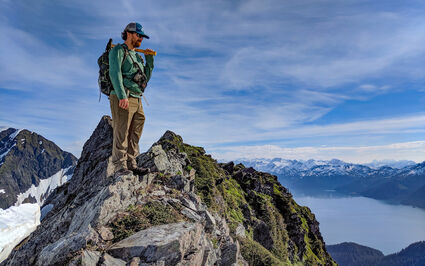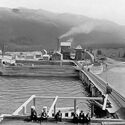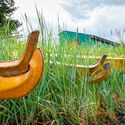Purpose, tradition guide Chugach Alaska
ANCSA corp. explores mineral opportunities that create a valuable, sustainable Chugach for generations of shareholders North of 60 Mining News – December 1, 2019
Last updated 9/26/2020 at 11:19am

Chugach Alaska Corp.
Matt Ellis, the resource specialist for Chugach Alaska's land and resources department and a shareholder descendant of the corporation, investigates a mineral prospect on Chugach land in the Kenai Fjords.
Stretching along roughly 400 miles of Alaska's southern coast – from the north end of the Southeast Alaska Panhandle near Icy Bay to the tip of the Kenai Peninsula near Homer – the Chugach Alaska Corp. region epitomizes Alaska beauty.
This 10 million-acre region along Gulf of Alaska coastline is carved with majestic fjords and bays teeming with fish, birds and marine mammals, and vistas of mountains and glaciers rising above and cutting through dense forests of hemlock and spruce.
In addition to the abundant subsistence, fishing, tourism and timber resources, the Chugach region is rich in minerals. Copper, zinc, chromium, titanium, platinum and gold are among the many metals that have been discovered and historically mined in this resource-rich area covering Prince William Sound and lower Cook Inlet.
For Chugach Alaska, one of the 12 land-holding Alaska Native regional corporations formed after President Richard Nixon signed the Alaska Native Claims Settlement Act into law in 1971, finding a balance between developing these minerals and other resources in the area and conservation is "driven by purpose, guided by tradition."
"A hallmark of the Chugach philosophy is our consideration for how the decisions we make today will impact the future health of the corporation," Chugach Alaska Executive Vice President of Lands and Resource Development Josie Hickel told Mining News. "With every decision we make, we ask ourselves whether we're creating a more valuable, sustainable Chugach for shareholders not only today, but for their children and grandchildren tomorrow."
To gain an understanding what role mining might play in this decision-making process, Chugach has begun to investigate the mineral potential in areas of historical mining on lands it owns in the region.
National forests, parks complicate
Under the Alaska Native Claims Settlement Act (ANCSA), Chugach is entitled to roughly 378,000 acres of full fee estate and 550,000 of subsurface estate to be managed for its shareholders.
As stewards of this beautiful and resource-rich region of Southcentral Alaska, Chugach seeks a balance between safeguarding the heritage of its nearly 2,850 shareholders, conserving the natural beauty and resources of this area that has been their home for thousands of years, while also ensuring economic opportunities for the people of the region.
With federal conservation areas such as the Chugach National Forest and Kenai Fjords National Park covering much of this region, however, realizing the economic opportunities that could come from developing mineral and other resources on its lands, which sometimes lie within these national parks and forests, can be complicated.
"As many are aware, the Chugach National Forest is approximately 98 percent inventoried roadless from the 2000-era Clinton Roadless Rule, which frustrates our rights for access to resources where we own the subsurface," Hickel told Mining News.
Despite the frustration, Chugach Alaska seeks to work with federal land managers within the U.S. Department of Interior, which oversees the National Parks Service, and Department of Agriculture, which is over the National Park Service.
"If we can find some symbiosis of an overall landscape management strategy that benefits our shareholders, we certainly consider that," the Chugach Alaska land and resource executive said. "Because we have a lot of the split estate concerns in areas of interest to the agencies, and also areas within designated Wilderness, or Wilderness Study areas, we are working with the departments of Interior and Agriculture for possible land exchanges that might alleviate some of these management concerns."
Land holdings in the Chugach region were further complicated following the Exxon Valdez oil spill.
Exxon Valdez Oil Spill Trustee Council acquired significant surface estates from village corporations in the Chugach region, creating split estates on lands Chugach Alaska owned the subsurface rights.
One such split estate was Port Gravina, where the regional corporation wanted to develop a granite quarry.
"Though it was quite an effort, in the end, we were able to assert our rights as the owner of the dominant subsurface estate and our granite products will be on the market soon," Hickel said.
Granite quarry, local jobs
Port Gravina is located on Prince William Sound between the communities of Valdez and Cordova. Granite mined from this Southcentral Alaska locale could provide materials for infrastructure, development, construction and repair projects throughout Alaska and the Pacific Northwest.
"A longer local development and shipping season could aid in the restoration of projects such as shoreline restoration and storm erosion control in Western Alaska, where some villages are at risk," said Hickel. "High-quality armor stone and rip-rap, which would be available through the Port Gravina project, are ideally suited for these types of prevention and restoration projects."
Receiving U.S. Forest Service approval of the Environmental Assessment needed to develop Port Gravina, Chugach began development at the quarry site in 2018.
Work completed so far includes quarry development, laydown pads and road linking the mine to the dock, which is currently under construction. The first shipments of granite from Port Gravina are expected to be shipped to Valdez and Seward for marketing in 2020.
For Chugach shareholders that live in the area, the new granite business means jobs – both at the quarry and the other jobs spurred by the economic opportunities it generates.
"These jobs are greatly needed in local villages where economic development and job opportunities are limited," Hickel said. "Local hire from communities closest to the project area will be utilized to the maximum extent possible."
Projects such as this lies at the heart of Chugach's balanced strategy.
"Chugach has a responsibility to shareholders to protect our heritage and cultural practices, provide stewardship over our lands and resources and to explore economic opportunities that benefit our region and shareholders," Hickel said. "This responsibility has led us to pursue a number of opportunities on our lands, the latest being the Prince William Sound Granite Quarry."
Investigating the mineral potential
Beyond mining granite that can be used for coastal infrastructure projects along Alaska's massive coastline, Chugach Alaska has recently resumed exploration of the other mineral resources known to exist on its lands.
While there are currently no operating mines in the Chugach region, several small underground operations produced copper, silver and other metals from high-grade ore mined from volcanogenic massive sulfide (VMS) deposits near the village of Tatitlek on Prince William Sound in the early 1900s.
While these historic mines and other prospects identified on Chugach-owned lands show promise, little exploration has been carried out in the area since the 1970s, at least until recent work by the regional corporation.
"In 2014 we did a phase one exploration program for Metallic Minerals on our lands in the VMS belt in the northeastern Prince William Sound, near Tatitlek," said Chugach Alaska Senior Manager of Lands David Phillips. "There has been past production of copper in the area from Ellamar, Threeman, Billy Goat, Reynolds Alaska and Schlosser mines."
While the village corporations in the Chugach region typically own surface estate and the regional corporation owns the subsurface mineral rights, the Tatitlek Village Corp. owns both the surface and subsurface rights to lands covering some of the VMS targets in this area.
Working with Alaska Earth Sciences, an Anchorage-based geological consulting firm, Chugach investigated an area on the southeast side of the Kenai Peninsula known to host high-grade gold.
"In 2019, we began a program in the Nuka Bay District of the Kenai Fjords," said Phillips. "Chugach owns approximately 78,000 acres of subsurface estate within the boundaries of the Kenai Fjords National Park."
While a report detailing the results from this work is not yet available, early indications are that Chugach's 2019 exploration turned up some intriguing targets for follow up exploration.
"We have only had a single field season in each location, but there seems to be enough interest to put together a more focused effort in certain areas," said Phillips.
The land manager said Chugach Alaska plans to explore mineral prospects that Chugach Alaska owns on Knight and Latouche Islands in Prince William Sound.
Based on work carried out in the 1970s, it is estimated that the Copper Bullion prospect on Chugach lands on Knight Island hosts 1.8 metric tons of resource averaging 0.57 percent copper, 42.4 percent iron, 0.15 grams per metric ton gold, and 3.16 g/t silver.
Latouche Island, on the other hand, hosts a major copper producing mine from early in the 20th century. From 1908 to 1930, the Beaston Mine on Latouche Island produced roughly 182.6 million pounds of copper and 1.47 million oz of silver from 5.43 million metric tons of ore averaging 1.65 percent copper and 8.72 g/t silver.
Chugach Alaska also plans to explore lands it owns within and adjacent to the Wrangell-St. Elias National Park, which hosts the world-renowned Kennecott copper mine.
Driven by purpose, guided by tradition
Chugach Alaska decisions are "driven by purpose, guided by tradition." As such, the ANCSA regional corporation wants to have a good understanding of the mineral prospects on its lands before bringing in mining or mineral exploration companies as partners to further evaluate and advance mineral projects within its region.
For Chugach and its shareholders, it is important that any mineral exploration and mining in the region, whether on ANCSA or public land, minimize the impacts on the environmental and aesthetic values this iconic part of Alaska is known for.
"Chugach places utmost value on habitat protection given the importance of subsistence to our shareholders and the reliance of regional communities on healthy water and land in Prince William Sound," said Hickel. "We make every effort to maintain a minimal footprint and avoid impacts to the natural habitat, and we would ask that other companies uphold this same respect toward our region."
Another thing that is important to Chugach is that any development in the region provide jobs for its shareholders that live there.
"It is fitting that the resources developed in the Chugach region benefit the Chugach people," the regional corporation penned on its website.
In addition to direct jobs at a mineral exploration camp or mine, the people of the region offer much in the way of logistical and other support.
"Many of the region's village corporations, tribes and our shareholders have businesses that provide marine transportation, cargo, and logistical services," Hickel said.
In addition, Chugach Alaska subsidiaries are ready to support development within the region.
Chugach Alaska Services, an Alaska Native focused staffing service, is particularly well suited for supporting mineral exploration in the region and across the state.
"While our focus is Alaska's oil and gas industry, we have the resources and the talent to provide professional and highly qualified individuals to any industry of Alaska's economy," CAS wrote.
By providing economic opportunities for Chugach Alaska shareholders, conscientious mineral exploration and mining may have a role to play in Chugach Alaska's strategy to create "a more valuable, sustainable Chugach for shareholders not only today, but for their children and grandchildren tomorrow."

Chugach Alaska Corp.
Bidarkas are traditional kayak-type boats used by Chugach shareholders and their ancestors for subsistence hunting and other excursions along the Gulf of Alaska.
EDITOR'S NOTE: "Purpose, tradition guide Chugach Alaska" is the 11th article in a 13-part series that investigates what the Alaska Native Claims Settlement Act means for Alaska's mining sector and its future. The remaining articles will continue to dig deeper into each of the land-holding Regional corporations; the mining lands that they own; and the services they offer to the mining sector. As a life-long Alaskan that has written about mining here for more than a decade, it is my hope that this series will provide a better understanding of ANCSA and serve as a guide to mining companies seeking to do business in The Last Frontier. For further information on ANCSA see An Alaska Native claims primer for miners published in the February edition of North of 60 Mining News.






















Reader Comments(0)